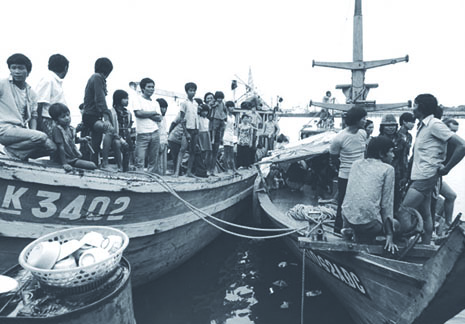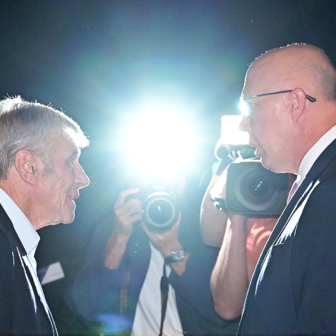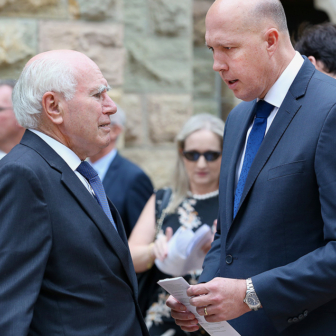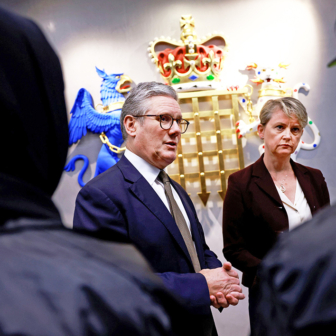ACCORDING to the United Nations High Commissioner for Refugees (UNHCR), at the end of 2012 there were 3.5 million refugees in the Asia-Pacific region and another five million “people of concern”, including internally displaced persons and returnees. In some countries, the numbers are very large: Thailand, for example, hosted more than 600,000 people of concern to UNHCR at the end of 2012, and Malaysia more than 200,000. Others – like Australia, which hosted 30,083 refugees and 20,010 people with asylum claims pending – have a much lighter burden.
Despite this imbalance in numbers, the debate in Australia treats boat arrivals as a unique phenomenon rather than a challenge shared with our neighbours. Travelling to Australia by sea is certainly very dangerous, but our starting point should be to consider how we can best ensure that people no longer feel that getting on a boat is their only option. This means Australia must begin to develop a regional system that strengthens protection for refugees along the route they take from their homelands. We need to make sure that they have access to safe, secure shelter and healthcare along the way, and are given the opportunity to pursue their own livelihoods.
The best way to deal with this complex issue is to develop policies in collaboration with other countries. The most-cited example of such an approach was the Comprehensive Plan of Action for Indochinese Refugees, or CPA, established in 1989 in response to the hundreds of thousands of asylum seekers leaving Vietnam overland and by boat. Under the agreement, countries of first asylum agreed that they would allow people to remain, without threat of expulsion, while their cases were being considered. Resettlement countries (including Australia) promised to take refugees in significant numbers. For its part, Vietnam agreed to work with the international community on orderly departure arrangements and accept the return, without penalties, of people found not to be refugees. Almost 125,000 refugees were resettled under the CPA.
In 1996 the Steering Committee for the CPA, under the chairmanship of the UNHCR, declared that the CPA had successfully met its objectives and would subsequently come to an end. This invited disappointment from regional governments which still hosted sizeable numbers of mandated refugees in their countries.
As a consequence, regional governments are wary of countries like Australia raising the possibility of new regional arrangements. Are we just out to “fix” our problem, or are we proposing a genuine collaboration? For countries in the region, our domestic debate about “boat people” suggests that it’s the former.
Yet there are promising signs that a new regional dialogue is developing. This is best seen in the Bali Process on People Smuggling, Trafficking in Persons and Related Transnational Crime, which began with a crime-based focus on people smuggling and trafficking activities but has progressively shifted to encompass the humanitarian dimensions of displacement, people smuggling and population flows. The most recent Bali Ministerial Conference, in April this year, acknowledged that displacement has both a humanitarian dimension and a criminal element.
The Houston Expert Panel on Asylum Seekers shared that view. At its heart was the acknowledgement that “strategies need to shift the balance of Australian policies and regional arrangements, to give greater hope and confidence to asylum seekers that regional arrangements will work more effectively.” Yet the discussion of the report’s recommendations lost sight of that key point by focusing only on selected aspects of the panel’s recommendations, such as offshore processing arrangements in Nauru and Papua New Guinea.
Regional arrangements provide a humane and responsible way to stabilise population movements. Where alternative protection arrangements are available in transit countries, people will have less incentive to risk a sea journey. In other words, regional arrangements are the only way of addressing “push” factors, and are likely to be more ethical and effective than the deterrence-based policies we see today, which address only “pull” factors.
We know from experience that people displaced by war and conflict largely remain within their region of displacement – some 80 per cent of them, according to the most recent Global Trends Report from UNHCR. Most displaced people want to return to their homes and livelihoods as soon as it is safe to do so. They continue to move when the protection in the country of first asylum becomes precarious – as it is for Hazara Afghans in Pakistan and Iran, for example – or when, with time, they lose faith in the possibility of returning home or have no opportunity to build futures for their families where they are. It is in circumstances like these that smuggling networks prey on the vulnerabilities of already vulnerable people.
To support these displaced populations and minimise their need to move on, Australia needs to collaborate with other countries in the region to develop a set of agreed, practical policies.
These could include creating an effective reception and registration system for displaced people in the region. Done well, using a collaborative approach, this could eventually lead to a common asylum and screening process irrespective of where a person is living. Also important would be creating a “legal space” where displaced people can live. Where displaced people feel safe they are much less likely to move again, so Australia should work with regional governments to develop a category of legal status (not dissimilar to Australia’s bridging visa regime, for example) for displaced people while their claims are being processed.
Opening such a “protection space” could lead to better support for asylum seekers, including housing, schooling, skills training and healthcare. Developed in coordination with local NGOs and other groups, it would have the potential to provide broader economic and social service benefits for displaced people and their host communities.
Such arrangements take time to develop. Establishing a formal partnership of governments and civil society under the auspices of the Bali Process could well create a less politicised environment in which to explore the options.
When the international community negotiated orderly departure arrangements with Vietnam under the CPA, the motivation for informal migration was greatly reduced. Drawing on that experience, Australia could develop plans for orderly departure from source countries such as Afghanistan and Sri Lanka, and look at creating special programs that would complement the refugee resettlement program. We have done this before and could do it again.
While the High Court ruled against the Australian government’s agreement with Malaysia, processing asylum seekers in the region could still have a place in a new regional approach. This would be particularly appropriate if the regionally consistent asylum processing arrangements, described above, were in operation, thus negating the need for onward movements. Such an arrangement is not of itself a solution, however. It needs to be regarded in the broader context of supporting the continued development of a regional framework, which would include resettlement and return of non-refugees, as well as addressing the question of smuggling coordinators and facilitators.
In 1998, UNHCR’s executive committee discussed the possibility of transferring people from one state to another for processing and concluded: “It should be established that the third country will treat the asylum seeker(s) in accordance with accepted international standards, will ensure effective protection against refoulement, and will provide the asylum seekers with the possibility to seek and enjoy asylum.”
Bali Process ministers have also endorsed the concept that states should explore such arrangements. These opportunities should be pursued, because they have the potential to contribute to building a durable protection system in the region.
We have the chance to develop sensible and realistic policies and should embrace it. If done well, Australia would be assisting in the development of a new and enduring protection framework in the region – sharing the weight and supporting states to build practical and responsive systems to support displaced people in the region.
As anyone who has worked in the region on these issues knows, it will take time, confidence and trust to pull this off, especially while the Australian debate remains divisive and treats our regional neighbours as if they are “doing nothing.” We should be working to create the conditions in which effective protection is not a burden but a sensible way of dealing with asylum seekers in the region.
When the CPA was introduced it faced much criticism, but today it is seen as a model of regional cooperation. It took political will and leadership to envisage an alternative path then, and if we have the courage we could do it again. •




